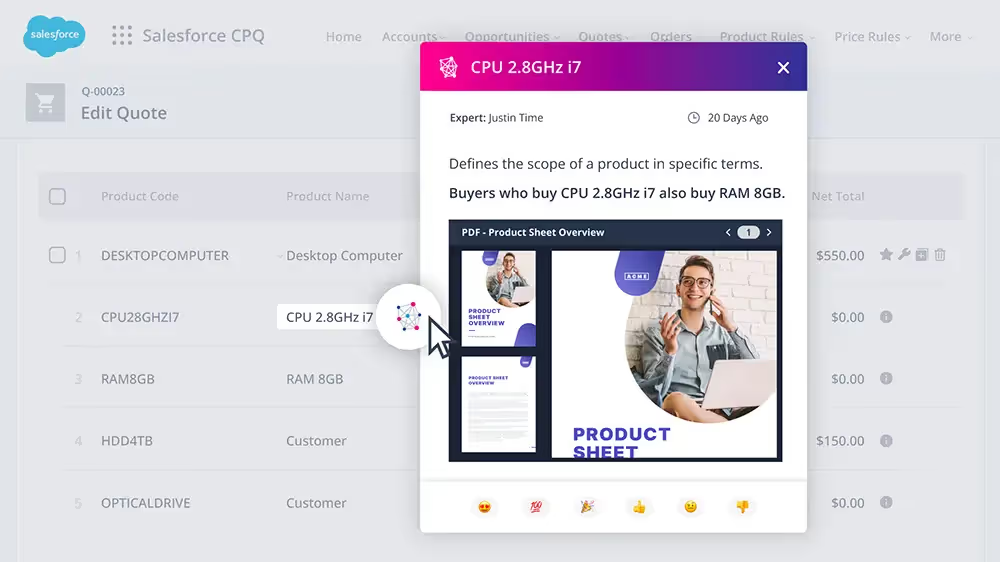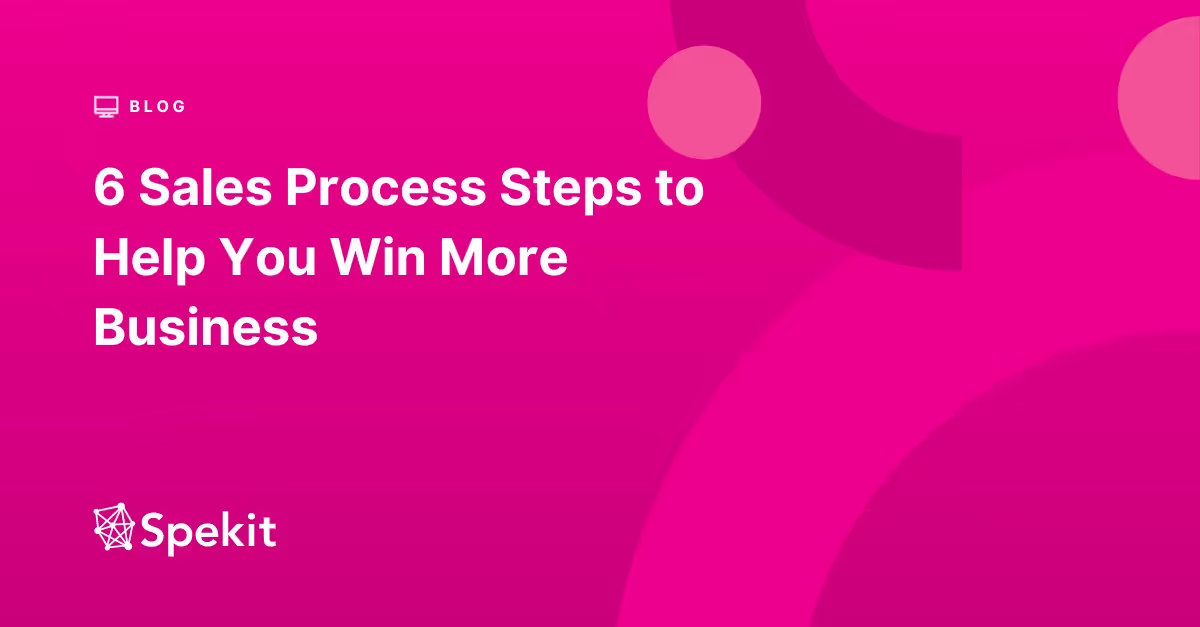What are sales process steps? Simply put, your sales process steps will define your sales reps’ journey as they navigate the prospect and customer relationship. Clearly defined steps will be outlined in a streamlined sales process to drive consistency, alignment, and, ultimately, revenue.
A sales process is a series of repeatable, planned steps that map out a sales rep’s journey as they guide a prospect to an approved contract and beyond. The “beyond” part might surprise you. However, you’ll learn that beyond can be the most profitable leg of the journey, especially in B2B sales. At some point, the sales leadership and a select group of people (or it may be yourself) establish and refine the sales process steps that your team will follow to close new business.
Cultivating relationships is a vital part of the sales process steps
Laying out the roadmap to find the kind of people who will lend you (or your salespeople) their ears and give you time on their calendars can be time-consuming. You’ll meet over cups of coffee; then they’ll convince their colleagues and their boss to meet you too – be it in their office or virtually. Then finally, in the not too distant future, they’ll be convinced of the considerable value of your products and services and arrange to pay you for them. As you nurture this relationship, you can begin this sales process cycle again with another.
1. Define and refine your book of business and sales pipeline
You might think prospecting is the first sales process step. Yet, before you pick up the phone or step out the door, you should clarify just what your addressable market is for your success (and sanity). Fail to plan, plan to fail, as the saying goes.
Are your products or services ideally suited to manufacturers in Michigan? Dentists in Denver? Airlines across America? Whatever your ideal prospect is, make sure you can identify some decision-makers to contact within your target audience or influencers who might champion your cause and help you access those decision-makers. The product, service training, and research are essential to this step; however, the best salespeople are curious, constant learners, so training is not a finite step.
Market research is vital before jumping into prospecting, whether you are a sales rep, manager or working in a market intelligence role. Established businesses with extensive prospect and customer data in their Salesforce CRM have a distinct advantage over startups, though third-party data services can help level the playing field. Your ability to navigate through account, contact, and opportunity histories while onboarding will be critical to your success. Take advantage of any opportunity to accelerate ramp-up time with your company’s CRM.

2. Prospecting and communications
Cold calling, networking, and digital outreach can test the “mettle” of any sales rep. They’re critical to filling and replenishing the sales funnel. The time you spent researching your new territory in the last sales process step should pay off here. Try to approach each conversation with an understanding of the roles of the people you connect with to tailor your approach accordingly. A CFO or COO will be keen on how you can help them increase efficiency and contain costs. At the same time, a VP of Sales will be interested in maximizing profitability and generating revenue.
Don’t make closing a deal the goal of your prospecting calls, especially if you sell high-value, complex solutions. Just try to close on getting on a prospect’s calendar for a discovery meeting or call. You’ll ease the pressure from your shoulders when you build rapport with prospects, demonstrating you value their time. To get a prospect’s buy-in for a discovery call, prove you understand their business and connect what your company offers with a challenge they face. Don’t ask a prospect what keeps them up at night; that trope was worn out long ago.
Position the discovery call as a means of learning about their business and an opportunity for your prospect to learn from your company’s experiences and interactions with their industry peers. That kind of intellectual capital (without revealing any competitive secrets) should be compelling enough to get on their calendar. If you can schedule discovery and presentation conversations on a prospecting call, pat yourself on the back.

3. Discovery conversations and meetings
Discovery meetings or calls can be one-on-one conversations or group calls. They are a critical exercise to determine whether a prospect has a need that your company can address within a reasonable time and a realistic budget. Take lots of notes that you can use to tailor your presentation.
You shouldn’t be presenting your products and services as much as asking questions to shape the presentation. Ask questions and practice active listening to uncover any needs or pain points your business can solve.
Ideally, you’ll want to learn what they gain with your products and what they stand to lose if they do nothing. This helps shape your future conversations. Curiosity is a good trait for salespeople to build relationships, unearth root causes, and build rapport.
Have the confidence to ask open-ended questions about a customer or prospect’s business to open conversations instead of giving your elevator pitch or value proposition, and be prepared to handle objections and proactively broach any objections you can anticipate in advance.
It’s ideal to separate a sales presentation or demonstration until you can tailor them based on your discovery call. You might even find a prospect’s needs don’t align with your product and wish each other well instead of wasting time. Even better, prospects appreciate this tactic and are more likely to come back if the fit is better later.
4. The sales presentation/demonstration
A sales presentation will go well if you’ve done an excellent job asking questions and gathering requirements during your discovery conversation. Resist the urge to write your whole presentation on a slide deck, as your prospect will lose interest and tune out. A few words on a slide deck with critical points or statistics will go far if you can present your notes and match your unique sales proposition with the customer’s needs. Try maintaining eye contact as much as possible, and don’t get absorbed in your slides. The same is true whether you are presenting online or in person.
The sales presentation is a real moment of truth as a sales process step. It can convey that you genuinely believe in the value of what you are selling or are just going through the motions. To close a deal, ensure you’re prepared, polished, and presentable.

5. Close the deal
You don’t have to follow the Glengarry Glenn Ross advice of “Always be Closing” as a sales professional; however, don’t let a presentation end without trying to close the deal with a “soft close.”
What will be your defined exit criteria for wrapping up a deal? A sales process example is asking a prospect if they see value in what you presented and would be interested in a proposal. Some deals fall apart because a salesperson didn’t ask for a customer’s business when they expected an offer.
Your sales enablement team can provide coaching and guidance on contract terms, pricing, and the delivery of products or services. As a sales process step, equal parts art and science, it’s a delicate (but critical) skill to learn. Sales managers who’ve “carried a bag” in the field should share the secrets to their success in closing deals. If a sales call “ride-along” can help close a high-value sales deal, go for it. Or, sales managers can share “fireside chat” stories for different closing scenarios in your sales enablement content.
The thrill of closing a deal and achieving “your number” is an exhilarating experience. It’s why many sales professionals keep at it. You never win business if you don’t ask for it, and all of the preparation and perspiration along the way pays off when a prospect agrees to your offer.

6. The final sales process step: Post-sale follow-up
Getting a signed sales agreement isn’t the last sales process step. It’s critical for a sales professional to follow up with their new customer to:
- Ensure your company is delivering/delivered what was promised
- See if there might be incremental needs that the initial purchase didn’t address
- Explore (when it’s appropriate) whether the customer would agree to give a testimonial, be profiled in a case study, or refer you to their associates in other businesses for opportunities.
A closed contract may mean that a successful manager or an account executive may take over the lion’s share of interactions with a new customer. Yet, a sales specialist should always keep customers “in their orbit” for follow-on opportunities.
Having a repeatable sales process that works for your product, team, and industry will make the difference between success and failure. That alignment requires a similar repeatable onboarding process and ongoing cross-team communication. Find ways to educate your sales team about the finer details of your company’s sales process and to update them on any changes along the way. Share a sales process step flowchart, a cheat sheet, or a sales playbook; just don’t hide it under a rock.
To learn more about Spekit’s just-in-time learning platform and how it can transform your sales enablement training and revenue team success, request a demo of Spekit today!
Related Articles:
- Mastering the Sales Process: How to Increase Conversion Rates with Just-in-time Learning
- The Ultimate Step-by-Step Sales Process Template (2023)
- How to Build Your Sales Process in Spekit







